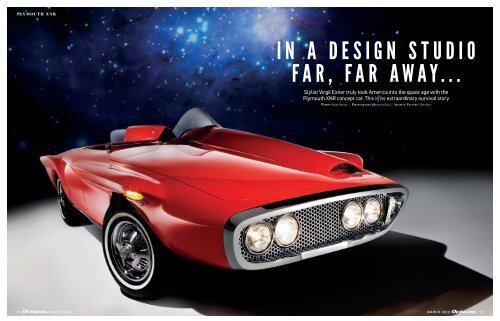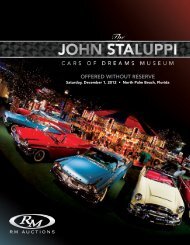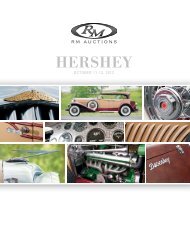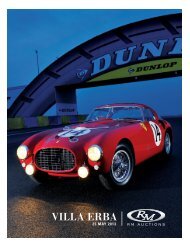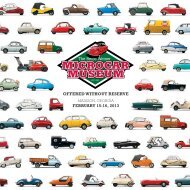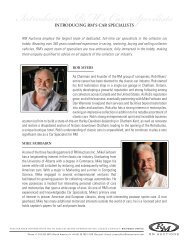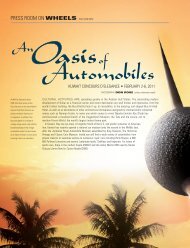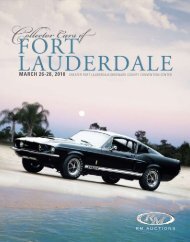IN A DESIGN STUDIO FAR, FAR AWAY... - RM Auctions
IN A DESIGN STUDIO FAR, FAR AWAY... - RM Auctions
IN A DESIGN STUDIO FAR, FAR AWAY... - RM Auctions
Create successful ePaper yourself
Turn your PDF publications into a flip-book with our unique Google optimized e-Paper software.
PLYMOUTH XNR<br />
94 MARCH 2012<br />
<strong>IN</strong> A <strong>DESIGN</strong> <strong>STUDIO</strong><br />
<strong>FAR</strong>, <strong>FAR</strong> <strong>AWAY</strong>...<br />
Stylist Virgil Exner truly took America into the space age with the<br />
Plymouth XNR concept car. This is its extraordinary survival story<br />
Words Matt Stone // PhotograPhy Shooterz.biz // archive Picture Chrysler<br />
MARCH 2012<br />
95
PLYMOUTH XNR<br />
TODAY MOST PEOPLE refer to<br />
them as ‘concept cars’. You know,<br />
those one-off dream machines,<br />
mock-ups, design studies and<br />
turntable toys intended to dazzle<br />
us at motor shows, give potential<br />
customers and the media a hint<br />
at specific vehicles or automotive<br />
design language that’s coming in the near<br />
future, and possibly even gauge reaction to<br />
them. Virgil M Exner Sr had a different<br />
name for them – he called them ‘Idea Cars’<br />
because, to this visionary designer and design<br />
department leader, the power of good ideas<br />
was what it was all about.<br />
Exner began his career as an advertising<br />
illustrator and, as a rising design star<br />
and protégé of GM design boss Harley Earl,<br />
he ran the Pontiac styling department,<br />
before leaving to join Raymond Loewy and<br />
Associates in 1938 to work primarily on<br />
Studebaker projects. His relationship with<br />
Loewy was star-crossed at best and he was<br />
dismissed by Loewy in 1944, only to join<br />
Studebaker directly – although Loewy gets<br />
much of the credit for Studebaker’s fresh<br />
post-war designs, a lot of the effort should<br />
more correctly be credited to Exner. Exner left<br />
Studebaker in 1949 to join Chrysler’s design<br />
studio, ultimately to become its styling chief.<br />
96 MARCH 2012<br />
Exner rightly assessed that Chrysler’s early<br />
post-war cars were staid and boxy, and set<br />
to work to revolutionise their look to be more<br />
in step with the new post-war jet age. His<br />
‘Forward Look’ designs were sexy and<br />
exciting, and sales improved dramatically.<br />
‘Ex’, as he was affectionately nicknamed,<br />
respected the great work of Italy’s<br />
coachbuilders, and established a friendship<br />
and business relationship with one of the best:<br />
Luigi Segre ran Ghia in Turin, and Exner saw<br />
the value of a relationship with an Italian<br />
carrozzeria that could turn out affordable,<br />
high-quality one-offs in relatively little time.<br />
There soon followed a decade-plus parade of<br />
Idea Cars that enthused the public, the media<br />
– and Chrysler customers.<br />
In an internal catalogue about Idea Cars,<br />
Chrysler stated that such a car ‘…had to be<br />
more than just a show car that was simply a<br />
production model with special paint and<br />
upholstery. Yet it couldn’t be an impractical<br />
“dream car”. It had to have a completely new<br />
body that would interest and even startle the<br />
casual observer. It had to have new, practical,<br />
usable ideas in styling and accommodation.’<br />
The Idea Cars are well known to anyone<br />
who is a student of automotive design, and<br />
include landmarks such as the Chrysler<br />
Special, the K-310, Flight-Sweep I and II, the<br />
original DeSoto Adventurer and Adventurer<br />
II, the GS-1, Plymouth Belmont, several<br />
iterations of Dodge Firearrow and many<br />
others. Of the 28 vehicles built between 1940<br />
and 1961 that Chrysler identifies as Idea Cars,<br />
24 were built in co-operation with Ghia –<br />
largely designed by Exner and his staff in the<br />
USA, then detailed and built in Turin. A few<br />
were produced in limited numbers, such as<br />
the GS-1, plus a brief run of long-wheelbase<br />
Chrysler Crown Imperial limousines.<br />
In the late ’50s, Exner felt that Plymouth<br />
needed a sports car. Chevrolet had the<br />
Corvette, Ford had had success with the<br />
original two-seat Thunderbird of 1955-57,<br />
Jaguar had the XK (and made racing history<br />
with the C-type and D-type); plus there were<br />
Austin-Healey, Maserati, Porsche, Ferrari<br />
and others. And Ex had just the parts and the<br />
team to get the job done.<br />
He went to work putting all his ideas<br />
together in one place for a radical, wedgeshaped<br />
roadster that became known as XNR.<br />
Say that quickly and it sounds like the name<br />
of the man who conceived it, and the legend<br />
goes that the car was so-named by Exner’s<br />
Advanced Styling studio team. It was built by<br />
Ghia during the latter half of 1959 on a<br />
modified Plymouth Valiant frame provided<br />
by Chrysler, and made the rounds of the<br />
world’s great international auto shows in 1960,<br />
dazzling the crowds and the media, appearing<br />
on 1961 covers of American motor magazine<br />
giants Road & Track and Motor Trend.<br />
XNR incorporated several asymmetrical<br />
design features, including a bonnet scoop that<br />
begins on the driver’s side and tapers back to<br />
form the basis of a cowl for the instrument<br />
cluster, steering wheel, and racing-style<br />
windscreen. Those lines continue past the<br />
cockpit, culminating in a fin resembling that of<br />
a Jaguar D-type. The front edge of the fin is<br />
padded as a driver’s headrest.<br />
The tail ends in a heavily chromed, fourpointed-star-shaped<br />
rear bumper, with the<br />
vertical line of the star offset to the left of the<br />
car, in line with the driver, the steering wheel,<br />
tailfin and front bonnet scoop. It’s strictly a twoseater,<br />
and the passenger side of the cabin can<br />
be covered by a removable metal tonneau.<br />
‘EXNER SAW THE VALUE OF AN ITALIAN<br />
CARROZZERIA THAT COULD TURN OUT<br />
AFFORDABLE, HIGH-QUALITY ONE-OFFS’<br />
MARCH 2012<br />
Above and below<br />
Motor shows were the XNR’s<br />
natural habitat; nowadays it acts<br />
as a reminder that the 1960s<br />
was an era of ‘anything goes’<br />
in American car styling.<br />
97
PLYMOUTH XNR<br />
98 OC MARCH T OBER 2012 2011<br />
The wheels are highlighted by pontoonish<br />
wing shapes that emphasise power and<br />
aerodynamic purpose. And although the<br />
wheels themselves look as if they have knockoff<br />
hubs and contain finned brake drums, the<br />
effect is created simply by affixing racylooking<br />
hubcaps to conventional steels.<br />
The heat-shielded dual exhaust muffler<br />
system is mounted sidepipe-style just below<br />
the driver’s door, and you might expect one of<br />
Chrysler’s massive hemi-V8s mounted under<br />
that long, asymmetrical bonnet to breathe out<br />
through it. Not so.<br />
In 1960, Chrysler was going into battle<br />
against the Chevrolet Corvair and Ford Falcon<br />
in the compact car wars with the Plymouth<br />
Valiant, which employed a sturdy ladder<br />
frame, torsion-bar front suspension and a<br />
leaf-sprung live rear axle. As well as its chassis<br />
frame, the Valiant donated its new, overheadvalve<br />
2.8-litre slant-six, inclined by nearly 30º<br />
towards the passenger side to maintain a low<br />
profile, and treated to a warm-up by the<br />
racing division, including the Hyper-Pak<br />
intake and exhaust system, a Carter fourbarrel<br />
carburettor, and a more aggressive<br />
camshaft. Rated output was 250bhp, certainly<br />
enough to compete with the Jags, ’Healeys,and<br />
Aston Martins of the day. It transmits power<br />
via a three-speed manual gearbox with a<br />
close-coupled floor-shifter.<br />
Left and below<br />
Extravagant sidepipe<br />
belies the fact that there’s<br />
an economy-car slant-six<br />
under the bonnet; cockpit<br />
is exquisitely detailed.<br />
The interior is a study in polished<br />
aluminium and sturdy black leather. A racy<br />
set of instruments faces the driver through<br />
the drilled-spoke, wood-rimmed steering<br />
wheel, and instead of a glovebox there’s a<br />
hard leather case that can be detached and<br />
worn over the shoulder. From the passenger<br />
seat, it’s clear this car is highly driver-centric,<br />
an effect that’s accentuated by fixing the<br />
passenger-side tonneau panel in place.<br />
Exner’s creation isn’t huge but it’s hardly<br />
compact: at 195.2in, it’s nearly two feet longer<br />
than a Jaguar E-type, and about 6in wider.<br />
Exner’s dream of a new sports car based on<br />
a production saloon wasn’t to come true. Its<br />
looks were too outlandish, its bodywork too<br />
complicated to produce. After the XNR’s tour<br />
of duty, it was returned to Ghia and later<br />
sold to a customer in Geneva. The XNR was<br />
subsequently spotted in Switzerland by one<br />
Mohammad Reza Pahlavi – otherwise known<br />
as the Shah of Iran.<br />
The Shah, quite the enthusiast in his own<br />
right, was smitten by it, and convinced the<br />
Swiss owner to sell. After that, the ownership<br />
waters grow murky, but somehow it survived<br />
numerous wars and revolutions in Iran,<br />
and ended up in the hands of an exotic car<br />
dealer in Kuwait.<br />
Largely intact, the XNR made its way to<br />
Beirut, where it was hidden in a basement<br />
‘ITS LOOKS WERE<br />
TOO OUTLANDISH,<br />
ITS BODYWORK<br />
TOO COMPLICATED<br />
TO PRODUCE’<br />
MARCH 2012<br />
99
PLYMOUTH XNR<br />
for three decades. Amazingly, it survived the<br />
Lebanese Civil war, and businessman and<br />
automotive enthusiast Karim Edde bought it<br />
in the late 1980s.<br />
Edde wanted nothing more than to return<br />
the XNR to its former glory, but his search for<br />
the right people to restore it took 20 years. He<br />
turned to Rob Myers, the head of <strong>RM</strong> <strong>Auctions</strong><br />
and <strong>RM</strong> Restorations. Myers and his team<br />
know their stuff, having restored cars for<br />
several of the world’s most significant biggame<br />
collectors that have gone on to win Best<br />
in Show at Pebble Beach.<br />
Mario Van Raay, general manager of <strong>RM</strong><br />
Auto Restoration Inc, picks up the story: ‘The<br />
important stuff was all there, such as the body<br />
panels and difficult-to-remake parts such as<br />
those unusual bumpers. What wasn’t there, we<br />
remade. Fortunately, there are many great and<br />
detailed photos of the car, and from that we<br />
could recreate anything that was missing.’<br />
Some of the work was straightforward, other<br />
aspects more complicated. For example, each<br />
hubcap contains more than 30 individual metal<br />
pieces that had to be fabricated, largely by<br />
100 MARCH 2012<br />
hand. Van Raay said that Ghia’s original<br />
construction job was of good quality, but that<br />
time had taken its toll and everything needed<br />
to be redone. Exner’s son, Virgil M Exner Jr,<br />
also a successful designer, visited the car<br />
during restoration and was consulted on<br />
accuracy and detailing. The Hyper-Pak<br />
powertrain was intact and the original<br />
components were rebuilt and reused.<br />
Edde brims with justifiable enthusiasm<br />
about his car: ‘I just love this design, plus its<br />
historical importance.’ Its first major postrestoration<br />
debut was at the Amelia Island<br />
Concours d’Elegance last March – as you’d<br />
expect, the car draws a crowd wherever it<br />
appears. Octane caught up with the XNR for<br />
the second time at Pebble Beach last August.<br />
Prior to the concours itself, the car<br />
participated in the 75-mile Tour d’Elegance on<br />
the roads of the Monterey Peninsula, driven by<br />
Edde with his sister in the passenger seat. The<br />
XNR performed flawlessly, its throaty exhaust<br />
note speaking in more sophisticated tones than<br />
you might expect from an iron-blocked sixcylinder<br />
engine originally developed for an<br />
economy sedan. The XNR was a hit with the<br />
Pebble Beach judges too, earning two awards<br />
at the concours.<br />
Karim Edde takes satisfaction in that both<br />
he and <strong>RM</strong>’s skilled restoration team have<br />
saved the car and brought it back to its showpony<br />
specification and appearance, and has no<br />
immediate plans other than to continue to<br />
show it, and drive it when conditions permit.<br />
Don’t expect to see it crossing an <strong>RM</strong> auction<br />
block any time soon.<br />
Exner himself enjoyed much success,<br />
although he also lost his youngest son, suffered<br />
heart attacks, and had to bear the indignity of<br />
watering down his flamboyant design language<br />
for the 1962 model year.<br />
The ultimate insult? Chrysler Corporation<br />
dismissed him after those problem-plagued<br />
’62 models flopped in the marketplace. He<br />
formed his own design consultancy with son<br />
Virgil Jr, before passing away in his home state<br />
of Michigan in 1973, but he’ll always be<br />
remembered best for introducing the kind of<br />
space age cars you might expect from a man<br />
bearing the name Virgil Exner. End<br />
‘AS YOU’D EXPECT, THE<br />
CAR DRAWS A CROWD<br />
WHEREVER IT APPEARS’


